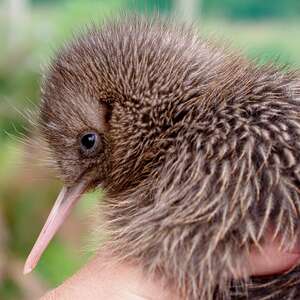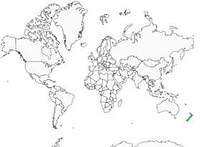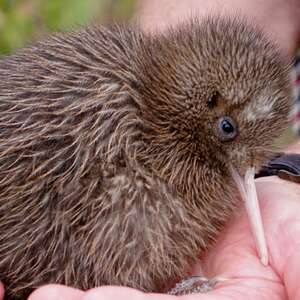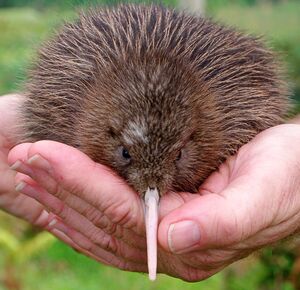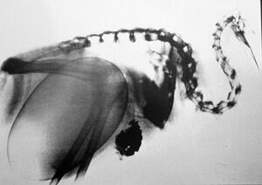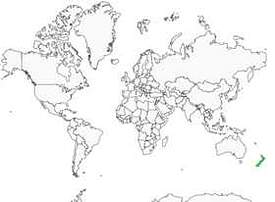Okarito Kiwi
Apteryx rowi - Kiwi d'Okarito
Identification
Okarito Kiwi is the rarest of kiwis. Endemic to the South Island, it is a nocturnal bird more often heard than seen. It is a large, brown kiwi with soft, pale brown feathers streaked with brown and black, short, strong tarsometatarses, as well as powerful feet, digits and claws. Its long, pale bill has nostrils at the end of the upper mandible that are slightly longer than the lower. It is an apterous bird, still having embryonic wings, and it does not have a tail.
Subspecific information monotypic species
Foreign names
- Kiwi d'Okarito,
- Kiwi de Okarito,
- kiwi-de-okarito,
- Okaritokiwi,
- okaritói barna kivi,
- Rowi,
- Kiwi bruno di Okarito,
- okaritokivi,
- Okaritokivi,
- kivi hodvábny,
- kivi okaritský,
- Okarito Kiwi,
- okaritonruskokiivi,
- kiwi d'Okarito,
- kiwi szary,
- Окаритский киви,
- オカリトキーウィ,
- 白眶几维,
- 奧卡里多褐鷸鴕,
Voice song and call
Habitat
Native podocarp lowland forest.
Behaviour character trait
The Okarito Kiwi is nocturnal. During the day, it rests in a burrow, a hollow tree or under thick vegetation, and emerges shortly after dusk. It feeds by slowly walking and tapping the ground, and when prey is detected, it probes the leaf litter; occasionally it may plunge its bill deep into the ground. Occasionally it emits a territorial call each night to signal its presence on its territory and keep in contact with the female. Pairs sing in duets, with the partner responding for several seconds after the first call. It is a very territorial bird, it fights with its congeners with sharp claws and talons.
Flight
It is a flightless bird, it has retained vestigial wings and has no tail.
Dietfeeding habits
He mainly feeds on small invertebrates, particularly earthworms, beetle larvae, cicadas and mites; he also consumes centipedes, spiders, crickets, Weta and crayfish, as well as certain fallen fruits.
Reproduction nesting
Okarito Kiwi is a monogamous bird, with a nest that is established in a burrow at the base of a hollow tree, or in a hollow tree trunk. Its breeding season stretches from July to March, laying a single large pale green egg from July until January. Incubation lasts from 70 to 80 days and the male incubates the egg more during the day, with both members of the couple sharing the task at night. The chicks are semi-precocial, leaving the nest at 5-7 days of age, they return to the nest for several months but are independent at 14 days. The egg may be accidentally destroyed by the kiwi's powerful claws. Juveniles disperse over no more than five kilometres, and they are able to reproduce from four years of age. It is a territorial bird and will fight its congeners with powerful legs and sharp claws.
Geographic range
Threats - protection
IUCN conservation status
concern
in the Wild
threatened
evaluated
By the 1990s, the population of Okarito Kiwis was in decline due to predation of chicks and young by stoats, and some adults killed by dogs and vehicles. In 1995, their population was estimated to be 160 birds. The 'Nest Egg' operation (removal of eggs or chicks from the wild for transfer to a rearing facility like the Department of Conservation's Franz Joseph Pre-Release Pens), then later transferring the birds from a minimum weight of 1.2 kg to predator-free Motuara Island until they could survive stoat presence, allowed the population to grow to approximately 200 birds in 2000. A large-scale trapping programme of the stoats in the South Okarito forest between 2001 and 2005 failed to protect chick predation. The Nest Egg operation was reinstated and the population again experienced rapid growth, to 375 birds in 2012. New populations had been introduced to Mana and Blumine Islands, but the birds there have yet to reproduce as they are not yet mature. IUCN status: endangered.
Sources of information
- IOC World Bird List (v15.1), Gill, F and D Donsker (Eds). 2025-12-07.
- Vol. 1 - Handbook of the Birds of the World, Josep del Hoyo-Andrew Elliot-Jordi Sargatal
- Handbook of Australian, New Zealand and Antarctic birds, 1: ratites to ducks., Marchant, S.; Higgins, P. J.
- Know your New Zealand Birds, Lynnette Moon
- The field guide to the birds of New Zealand., Heather, B. D.; Robertson, H. A.
- The State of New Zealand's Birds 2005., Wilson, K-J.
- xeno-canto, Sharing bird sounds from around the world,
- ARKive, Christopher Parsons
- Conservation-comments-NZ,
- HBW Alive,
- New Zealand birds and birding, Narena Olliver
Other sources of interest
 Specification sheet created on
30/07/2023 by Yann Cambon
Specification sheet created on
30/07/2023 by Yann CambonTranslation by AI Oiseaux.net
© 1996-2025 Oiseaux.net
- Accipitriformes
- Aegotheliformes
- Anseriformes
- Apodiformes
- Apterygiformes
- Bucerotiformes
- Caprimulgiformes
- Cariamiformes
- Casuariiformes
- Charadriiformes
- Ciconiiformes
- Coliiformes
- Columbiformes
- Coraciiformes
- Cuculiformes
- Eurypygiformes
- Falconiformes
- Galliformes
- Gaviiformes
- Gruiformes
- Leptosomiformes
- Mesitornithiformes
- Musophagiformes
- Nyctibiiformes
- Opisthocomiformes
- Otidiformes
- Passeriformes
- Pelecaniformes
- Phaethontiformes
- Phoenicopteriformes
- Piciformes
- Podargiformes
- Podicipediformes
- Procellariiformes
- Psittaciformes
- Pterocliformes
- Rheiformes
- Sphenisciformes
- Steatornithiformes
- Strigiformes
- Struthioniformes
- Suliformes
- Tinamiformes
- Trogoniformes

